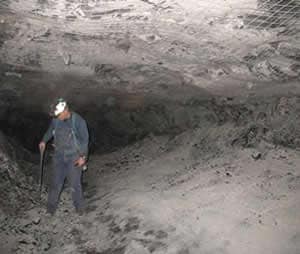Mining Feature: Ground Control Research: Considering Local Geology to Improve Longwall Pillar Stability
Wednesday, November 14, 2012
Designing safe mines is a central concern of the Office of Mine Safety and Health Research’s (OMSHR) Ground Control Program. Ground falls are the leading single cause of fatalities and injuries in underground coal mines, and from 2002 to 2011, an average of 6 fatalities and 520 injuries related to ground control occurred per year in underground coal mines. The program currently has two new projects that aim to enhance mine safety through improved longwall pillar designs that consider a mine’s local geology.

Coal Pillar
Sizing of coal pillars, which are blocks of coal left behind to support the weight of overlying ground, is an important part of coal mine design. “The basic approach is similar to that used in design of most any structure. The load capacity of the pillar should be greater than the loads applied on it, with a safety factor to protect against flaws and accidents,” ground control researcher Jeff Whyatt explains. However, both pillar strength and loading are subject to the volatility of mine geology, and important characteristics of the geology remain hidden during the mining process.
The ongoing research is working to improve pillar design for longwall mines in two ways. First, OMSHR is expanding and updating the database of pillar performance history that is used for load and strength estimates in its Analysis of Longwall Pillar Stability (ALPS) software. ALPS references a database of case histories to quickly determine if a design is consistent with pillar designs that have been successful at other mines. This software has been applied widely in the mining industry, especially for evaluating mine designs. In fact, some mines have used ALPS to better understand their experience with pillar performance. A new generation of ALPS software is being designed that can easily incorporate local information on mine geology and ground response. The new software will also include mining case histories collected over the past 15 years. Heather Lawson, a researcher on the ALPS project, elaborates on the necessity of this work: “We’re working to ensure that ALPS continues to be a useful tool to the industry as mining conditions and longwall practices advance.”
A second effort is seeking major improvements in the accuracy of estimated pillar loads and capacities. It builds on recent guidance from the Mine Safety and Health Administration (MSHA), published in MSHA’s Program Information Bulletin (PIB) 09-03, on validating a mine stress model to observed mine behavior. This approach builds estimates of pillar load and capacity by integrating ground observations and measurements of ground response into a sophisticated structural model of the mine site. “This approach is much more intensive than the ALPS method,” says Whyatt, who is working on this project, “but, ideally, it would provide an opportunity to discover and fix potential hazards in a computer simulation long before being encountered by mine workers.”
Both projects could provide options for mine designs that are more tailored to the unique environments at different mines, and in turn, reduce dangerous ground fall incidents.
- ALPS - Analysis of Longwall Pillar Stability - 5.4.02
- Analysis and Design Considerations for Superimposed Longwall Gate Roads
- Analysis of Multiple Seam Stability
- Design Methods to Control Violent Pillar Failures in Room-and-Pillar Mines
- Development of Stress Measurements and Instrument Placement Techniques for Longwall Coal
- Ground Control Software Toolbar - 1.1.02
- Local Earthquake Tomography for Imaging Mining-Induced Changes Within the Overburden above a Longwall Mine
- Pillar Design Issues for Underground Stone Mines
- Pillar Strength and Design Methodology for Stone Mines
- The State-of-the-Art in Coal Pillar Design
- Technology News 516 - ARMPS-HWM: New Software for Sizing Pillars for Highwall Mining
- Using the Coal Mine Roof Rating (CMRR) to Assess Roof Stability in U.S. Coal Mines